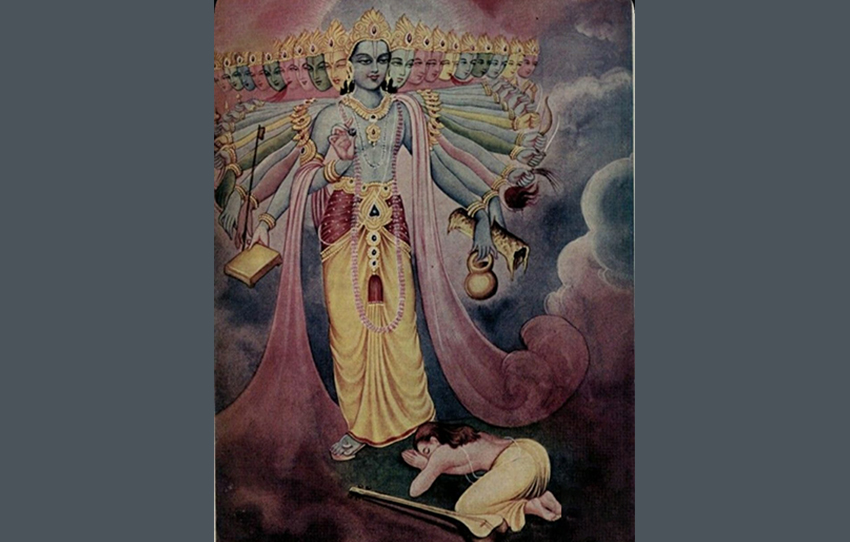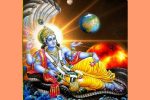NAME 25
Sarvaḥ सर्वः
He is everything and exists everywhere. The quality of the nirguṇa Brahman is being explained here. He is omnipresent and He is inconceivable. All that exists everywhere is nothing but His images. Everything is created by Him, sustained by His power and dissolved unto Him. This nāma affirms that this Sahasranāma teaches advaita philosophy.
Advaita is a philosophy of non-dualism. It is more to do with one’s personal experience than mundane theory. All that is not Brahman is negated and finally the One without a second is realised. For those who have realised the Self, everything else is superimposed on the Brahman.
Nārāyaṇīya (96.2) (composed approximately in 1560) says, “You are the individual self and you are the primeval matter (Prakṛti). There is no end to Your manifestations. There is nothing in the universe without you.”
२५. || ॐ सर्वस्मै नमः ||
25. Om Sarvashmaiy Namah
Sarvah -He who is the all. He being the One cause from which have sprung forth all things and beings. He himself is the all. In Mahabharata Udyoga Parva (70-12) we read: “As He is the origin and end of all, whether existent or otherwise, and as He, at all times, cognises all, He is called “Sarva”. All waves rise from the same ocean and, therefore, the ocean is the very essence in all waves. sarvah / (sa as in sanatana) One who is all – the cause of creation and destruction of all things.
INTERPRETATION GUIDED BY SANT VANI (WORDS OF SAINTS)
Sarvaḥ
The one who is (the source of) all.
He is known as sarva, not only because He is the cause of birth and dissolution of everything, but also sarvasyasarvadājnānāt, that is, always nowing everything. When we say, He nows everything; it means that He does not have any ignorance of anything (Maha Bharat Ud.69.11).
All the words in the ViṣhṇuSahasranāma are culled from the Śāstra. The Upaniṣads say, ‘sarvamkhalvidam brahma – all that is indeed Brahman.’ ‘Iśāvāsyamidamsarvam–all that is covered by Īśvara.’ Brahman is Parameśvara, who is the cause of sarva, this entire world. When we say ‘sarva-all,’ what are all included in this ‘all’? Any enumeration will be very long and still incomplete. Therefore, the śāstra uses methods of expressing in a short and comprehensive way.
One brilliant method is to say sat and asat–that which has a form and without a form–comprise sarva. All that is present in creation is sat and asat, that is, mūrta and amūrta. The elements space and air have no form. Even pleasure, love, anger and so on, have no form. The elements fire, (agni), water (āpaḥ), and earth (prithvī), the elementals and the physical body have a form. Therefore, those that have a form and those that have no form together constitute sarva, all. The Lord is called sarva, because from Him alone sarvasyaprabhava, the origin of everything takes place and unto Him alone sarvasyaapyaya, the dissolution of everything takes place. The pot that has come from the clay and goes back unto the clay, is sustained in between also as the clay alone. So too, everything is sustained by the Lord alone and is non-separate from Him.
Another method used, is to say ‘all’ means known and unknown. It includes our body-mind-sense-complex also. All that is here, known and unknown, is indeed Brahman. What is unknown now is known to someone else or knowable in the future. Again, known implies the knower and knowledge and all the three is the sarva. Further, in every action there are many factors involved, such as subject, object, instrument, location and so on, which are called kārakas, usually expressed with various case endings. These are also included in the ‘all.’ The word ‘all’ itself has relevance only when there is a manifest creation, because in the unmanifest state one cannot talk of ‘all.’ Therefore, any way that we look at it, all that is there is non-separate from Ishvara. Hence, He is called Sarva.



